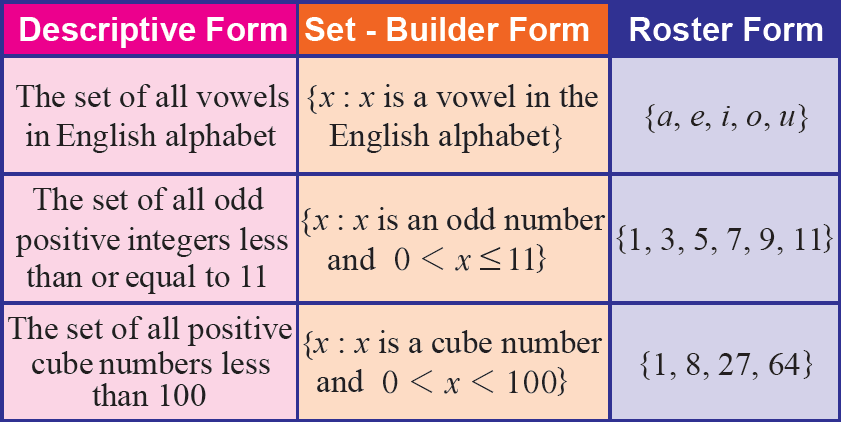REPRESENTATION OF SET
Subscribe to our ▶️ YouTube channel 🔴 for the latest videos, updates, and tips.
Set can be represented in any one of the following three ways or forms.
(i) Descriptive form
(ii) Set-builder form or Rule form
(iii) Roster form or Tabular form
Let us discuss the above different forms representation of a set in detail.
Descriptive Form
One way to specify a set is to give a verbal description of its elements.
This is known as the descriptive form of specification.
The description must allow a concise determination of which elements belong to the set and which elements do not.
For example,
(i) The set of all natural numbers.
(ii) The set of all prime numbers less than 100.
(iii) The set of all letters in English alphabets.
Set-Builder Form or Rule Form
Set-builder notation is a notation for describing a set by indicating the properties that its members must satisfy.
Reading Notation :

A = { x : x is a letter in the word "dictionary" }
We read it as
“A is the set of all x such that x is a letter in the word dictionary”
For example,
(i) N = {x : x is a natural number}
(ii) P = {x : x is a prime number less than 100}
(iii) A = {x : x is a letter in the English alphabet}
Roster Form or Tabular Form
Listing the elements of a set inside a pair of braces { } is called the roster form.
For example,
(i) Let A be the set of even natural numbers less than 11.
In roster form we write,
A = {2, 4, 6, 8, 10}
(ii) A = {x : x is an integer and -1 ≤ x < 5}
In roster form we write,
A = {-1, 0,1, 2, 3, 4}
Representation of set in Different Forms

Important points
(i) In roster form each element of the set must be listed exactly once. By convention, the elements in a set should not be repeated.
(ii) In a set, repetition of elements is meaningless. That is, once an element appears in a set, again it should not appear in the same set.
Let A be the set of letters in the word “coffee”,
That is, A = {c, o, f, e}. So, in roster form of the set A the following are invalid.
{c, o, e} -------> (not all elements are listed)
{c, o, f, f, e} -------> (element ‘f’ is listed twice)
(iii) In a roster form, the elements in a set can be written in any order.
The following are valid roster form of the set containing the elements 2, 3 and 4.
{2, 3, 4}
{2, 4, 3}
{4, 3, 2}
Each of them represents the same set.
(iv) If there are either infinitely many elements or a large finite number of elements, then three consecutive dots called ellipsis are used to indicate that the pattern of the listed elements continues, as in
{5, 6, 7,......} or {3, 6, 9, 12, 15,........60}
(v) Ellipsis can be used only if enough information has been given so that one can figure out the entire pattern.
Solved Problems
Problems 1-4 : Write the given set in roster form.
Problem 1 :
A is the the set of vowels in English alphabets.
Answer :
A = {a, e, i, o, u}
Problem 2 :
B is the set of letters in the word "follow".
Answer :
B = {f, o, l, w}
Problem 3 :
C is the set of all possible arrangements of the letters p, q and r.
Answer :
C = {pqr, prq, qpr, qrp, rpq, rqp}
Problem 4 :
D is the set of odd digits between 1 and 9 both inclusive.
Answer :
D = {1, 3, 5, 7, 9}
Problems 5-8 : Write the given set in set-builder form.
Problem 5 :
A is the the set of roots of the equation x2 - 3x + 2 = 0.
Answer :
A = {x : x2 - 3x + 2 = 0}
Problem 6 :
B is the the set of odd numbers between 0 and 10.
Answer :
B = {x : x = 2m - 1, m is an integer such that 0 < m < 5}
Problem 7 :
C is the set of even numbers between 2 and 10 both inclusive.
Answer :
C = {x : x = 2m, m is an integer such that 0 < m < 6}
Problem 8 :
D is the set of first 5 positive odd integers.
Answer :
D = {x : x = 2m - 1, m is an integer such that 0 < m < 6 }
Problems 9-12 : Write the given set in descriptive form.
Problem 9 :
A = {1, 2, 3, 4, 5, 6, 7, 8, 9, 10}
Answer :
A is the set of first 10 natural numbers.
Problem 10 :
B = {3, 6, 9, 12, 15}
Answer :
B is the set of first five multiples of 3.
Problem 11 :
C = {xyz, xzy, yxz, yzx, zxy, zyx}
Answer :
C is the set of all possible arrangements of the letters x, y and z.
Problem 12 :
D = {a, b, c, d, e}
Answer :
D is the set of first five alphabets in English.
Subscribe to our ▶️ YouTube channel 🔴 for the latest videos, updates, and tips.
Kindly mail your feedback to v4formath@gmail.com
We always appreciate your feedback.
About Us | Contact Us | Privacy Policy
©All rights reserved. onlinemath4all.com

Recent Articles
-
ASTC Formula in Trigonometry
Dec 23, 25 11:34 PM
ASTC Formula in Trigonometry - Concepts - Examples and Solved Problems -
Coin Tossing Probability
Dec 23, 25 11:29 PM
Coin Tossing Probability - Concept - Sample Space - Formula - Solved Problems -
Permutation and Combination
Dec 23, 25 11:28 PM
Permutation and Combination - Definition - Formulas - Shortcuts - Difference between permutation and combination
